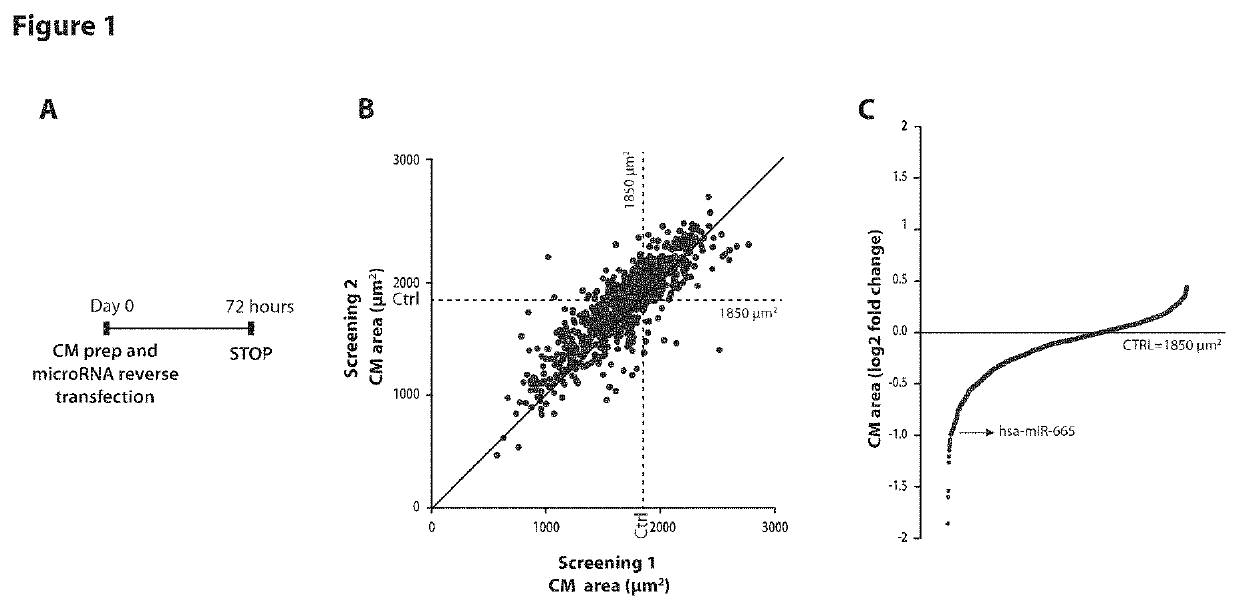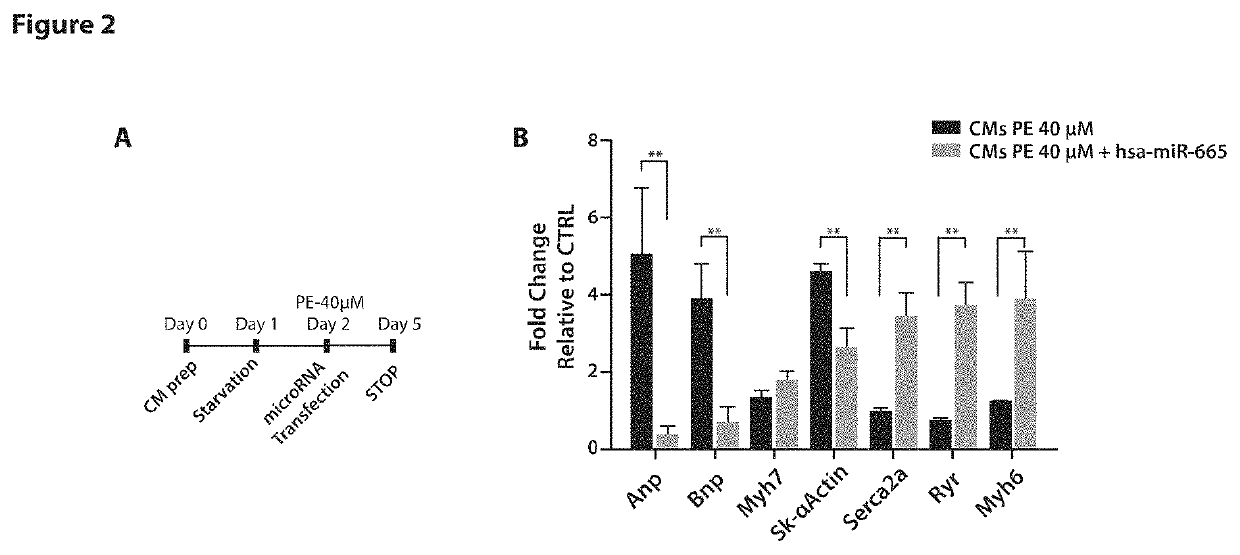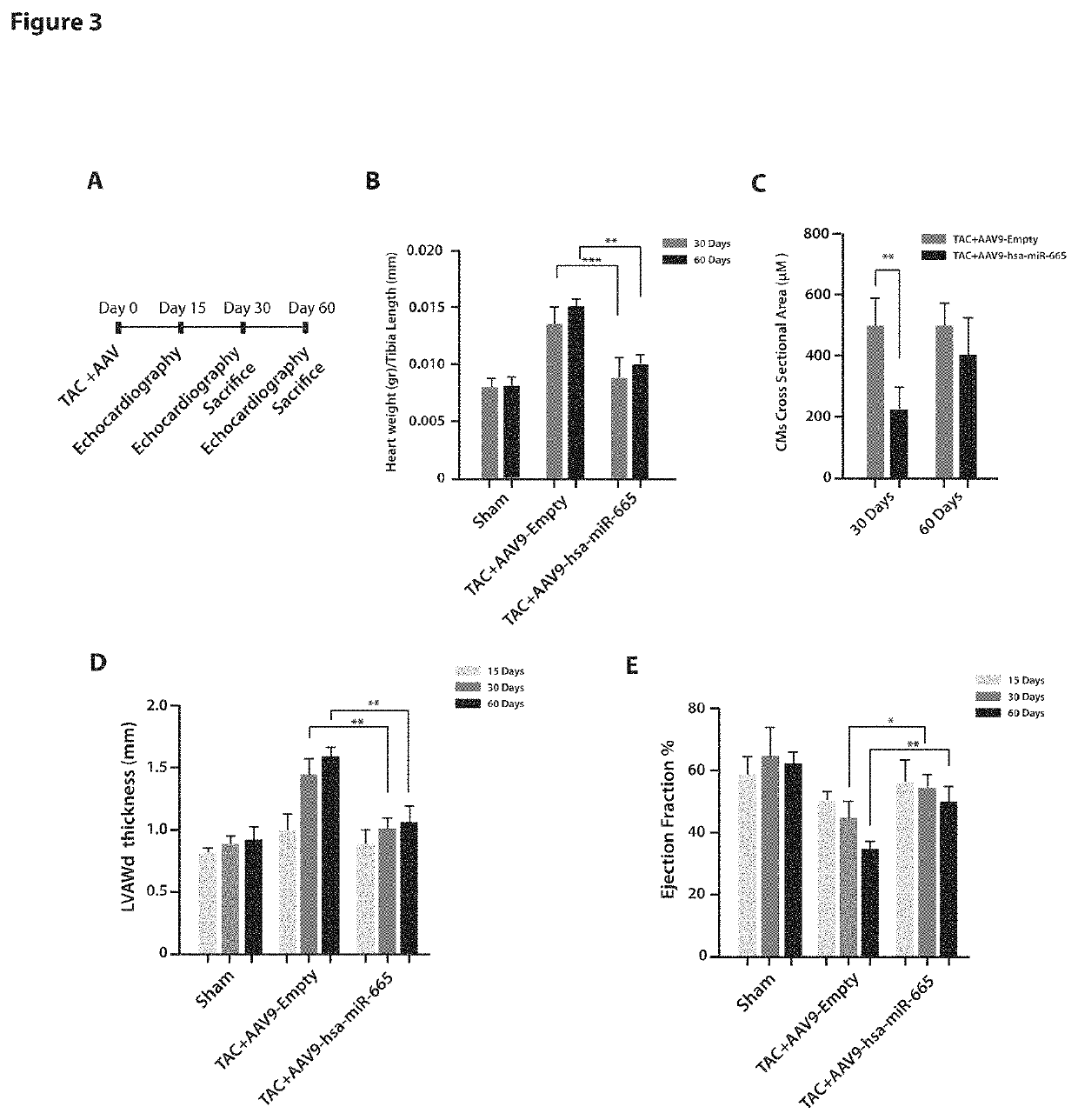MicroRNA hsa-miR-665 in cardiac hypertrophy
a technology of microrna hsamir-665 and cardiac hypertrophy, which is applied in the field of human microrna hsamir665 and can solve the problems of high hospitalization rate, severe impairment of quality of life, and missing working mechanism of this drug, and achieve the effect of restoring cardiac function
- Summary
- Abstract
- Description
- Claims
- Application Information
AI Technical Summary
Benefits of technology
Problems solved by technology
Method used
Image
Examples
example 1
[0084]High-Content, Fluorescence-Microscopy-Based, High-Throughput Screen Identifies microRNAs Able to Modify Cardiomyocytes Size.
[0085]A high-content, fluorescence-microscopy-based, high-throughput screen was performed in neonatal rat cardiomyocytes (CMs) using a library of 875 microRNA mimics (988 mature microRNAs, 875 unique sequences, miRBase release 13.0 (2009), http: / / mirbase.org). Cultures of neonatal rat ventricular CMs were reverse transfected with the library of microRNA mimics. After 72 h, the cells were stained for sarcomeric α-actinin to specifically measure CM size and number. (Experimental scheme in FIG. 1, panel A). The screening was performed in duplicate; the replicates showed very good reproducibility (Spearman coefficient 0.84; FIG. 1B). FIG. 1 panel C reports the effect of each microRNA on CMs cell size expressed as fold change over mock transfected CMs. On average, approximately 2500 cells were analysed per experimental condition and replicate.
[0086]We found 11...
example 2
[0087]Validation of the Screening Hits
[0088]Based on the screening results, we decided to validate and characterize the effect of the selected top microRNAs under both anti-hypertrophic and pro-hypertrophic conditions, with the specific purpose to assess the capacity of each microRNA to counteract or induce the hypertrophic phenotype. First, we investigated the effect of each microRNA on the expression of a set of genes previously associated with either pathological hypertrophy (foetal cardiac gene program: atrial natriuretic peptide (ANP), brain natriuretic peptide (BNP), β-myosin heavy chain (MYH7) and α-skeletal actin (sk-α actin) [4] or physiological hypertrophy (Serca2a, α-myosin heavy chain (MYH6) and ryanodine receptor (RYR) [4]. In particular, to examine the effect of microRNAs able to decrease CM cell size, we stimulated these cells with phenylephrine (PE), a known pro-hypertrophic stimulus, and simultaneously transfected them with individual microRNAs. Total RNA was extrac...
example 3
[0090]Hsa-miR-665 Counteracts the Onset of Hypertrophy and Preserves Cardiac Function after Transverse Aortic Constriction in Mice
[0091]To evaluate the anti-hypertrophic effect of hsa-miR-665 in vivo, we investigated whether this microRNA was able to prevent hypertrophy in a transverse aortic constriction (TAC) model of chronic cardiac pressure overload. Eight-week-old CD1 mice were subjected to TAC or sham surgery and, simultaneously, injected in the LV anterior wall (LVAW) with adeno-associated virus (MV) serotype 9 (AAV9) vectors expressing hsa-miR-665 or a control vector (1×1011 vg / animal; n=8 per group; FIG. 3, panel A). Our previous experience indicates that this procedure results in efficient myocardial transduction and month-long expression of the transgene [25].
[0092]As reported in FIG. 3 panel B, overexpression of hsa-miR-665 successfully counteracted, at both 30 and 60 days, the hypertrophic remodelling of the heart and maintained heart mass at physiological levels (30 da...
PUM
| Property | Measurement | Unit |
|---|---|---|
| size | aaaaa | aaaaa |
| diastolic stiffness | aaaaa | aaaaa |
| stiffness | aaaaa | aaaaa |
Abstract
Description
Claims
Application Information
 Login to View More
Login to View More - R&D
- Intellectual Property
- Life Sciences
- Materials
- Tech Scout
- Unparalleled Data Quality
- Higher Quality Content
- 60% Fewer Hallucinations
Browse by: Latest US Patents, China's latest patents, Technical Efficacy Thesaurus, Application Domain, Technology Topic, Popular Technical Reports.
© 2025 PatSnap. All rights reserved.Legal|Privacy policy|Modern Slavery Act Transparency Statement|Sitemap|About US| Contact US: help@patsnap.com



